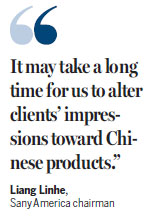Sany learns lessons in US, catches up
It took almost 10 years for Sany, the Chinese manufacturer of construction and material-handling equipment, to become profitable in North America.
Since opening a plant in Peachtree City, Georgia, in 2006, Sany America Inc has been manufacturing, selling and supporting their products in the US, Canada, Mexico and Central America.
"When we decided to come to the US, we estimated that it may take 7-8 years for us to start making a profit. It took a little longer, but we have achieved this goal, which is a milestone for Sany America," said Liang Linhe, senior vice-president of Sany Group and chairman of Sany America.
Sany's loader and road roller may enter the North America market by the end of 2016, and all product lines will show up in North America in three years, according to Liang. He said that among Sany America's different products, excavators are becoming more and more accepted in the US market.

"Though it took long to do it, sales for excavators in 2015 are pretty good; more than 400 were sold last year, which is one of the best records for a Chinese company in the US. We aim to sell 800 excavators by the end of 2016," Liang said.
He said that not only have sales increased, but so has recognition of Sany by clients.
"The evaluations we got for our excavators are very high. Our products are even better than some of the US products. And we do have a higher cost-performance ratio," he said.
However, compared to other world-class excavator makers, like Caterpillar Inc, Sany's market share for excavators is still at the third-tier level, with only about 4 percent of the market share, according to Liang.
"We are making all efforts to edge into the second tier, which means the market share will have to rise to 8 percent," he said.
Liang said he believes that one reason for the excavator not selling well is because "American clients tend to reject products from a Chinese company."
He said 2008 and 2009 represented the peak period when Chinese manufacturers came to the US, but he said most exited the market in 2011 and there are only a few left now, some of which have caused problems.
"Some Chinese companies sold products to American clients, but did not provide quality service. The prices are affordable, but the service is not good. This has left US clients with a negative impression of Chinese manufacturers," Liang said.
Sany made the same mistake, he said.
According to Liang, Sany's strategy toward the US market was similar to its strategy for its African market: a focus on sales, while service fell behind.
"Actually, in 2013, our US sales record was very good, reaching almost $600 million. But in the following year it started to fall, as our service did not catch up. So from 2014, we started to reconsolidate our strategy by enhancing our service system," he said.
"Now we are building up our service capacity, but it may take a long time for us to alter clients' impressions toward Chinese products. It also needs all Chinese manufacturers to work together on this issue," Liang said.
Despite this, Liang said he thinks Chinese manufacturing has advantages, and one is comparatively lower cost, "especially the cost of labor and cost of raw materials, which will be reflected in the price of the product".
Liang said that for certain products the price listed by Chinese manufacturers is only 70 percent of that listed by US manufacturers.
Another advantage he said is that Chinese companies' manufacturing technique is still competitive, which means the high value-added products it produces match the world's most advanced class of products, but with a lower price.
However, Liang said that standards and requirements in the US, such as emission standards, differ from those in China and Europe, so it takes more effort to innovate existing products and research and development for new products in the US.
"The research and development for the products in the US has to be two generations in advance of those in China," he said.
"We developed one model of our crawler crane especially for the North American markets, which meets standards in those markets. The new model is designed to reduce the cost of transportation for our clients in North America," Liang said.
"The market for port machinery was pretty dominated by Austrian companies. But gradually, our products have gained recognition among our clients in the US. We figured out that clients want machinery that is comfortable to operate, but they also want it to have good safety performance," Liang said.
leshuodong@chinadailyusa.com
(China Daily USA 05/31/2016 page2)


















